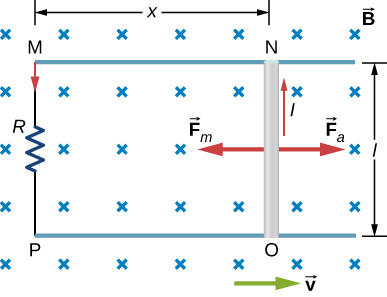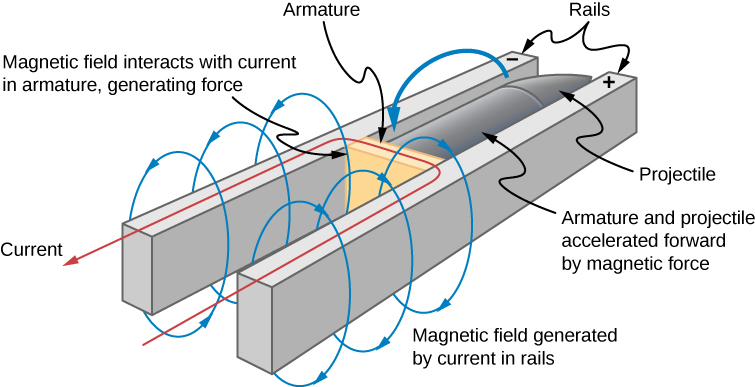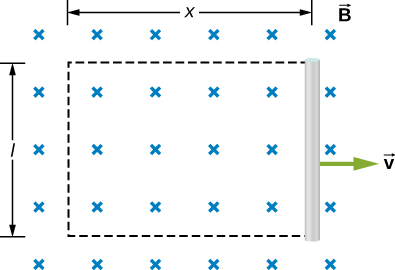| << Chapter < Page | Chapter >> Page > |

From an energy perspective, produces power and the resistor dissipates power . Since the rod is moving at constant velocity, the applied force must balance the magnetic force on the rod when it is carrying the induced current I . Thus the power produced is
The power dissipated is
In satisfying the principle of energy conservation, the produced and dissipated powers are equal.
This principle can be seen in the operation of a rail gun. A rail gun is an electromagnetic projectile launcher that uses an apparatus similar to [link] and is shown in schematic form in [link] . The conducting rod is replaced with a projectile or weapon to be fired. So far, we’ve only heard about how motion causes an emf. In a rail gun, the optimal shutting off/ramping down of a magnetic field decreases the flux in between the rails, causing a current to flow in the rod (armature) that holds the projectile. This current through the armature experiences a magnetic force and is propelled forward. Rail guns, however, are not used widely in the military due to the high cost of production and high currents: Nearly one million amps is required to produce enough energy for a rail gun to be an effective weapon.

We can calculate a motionally induced emf with Faraday’s law even when an actual closed circuit is not present . We simply imagine an enclosed area whose boundary includes the moving conductor, calculate , and then find the emf from Faraday’s law. For example, we can let the moving rod of [link] be one side of the imaginary rectangular area represented by the dashed lines. The area of the rectangle is lx , so the magnetic flux through it is Differentiating this equation, we obtain
which is identical to the potential difference between the ends of the rod that we determined earlier.

Motional emfs in Earth’s weak magnetic field are not ordinarily very large, or we would notice voltage along metal rods, such as a screwdriver, during ordinary motions. For example, a simple calculation of the motional emf of a 1.0-m rod moving at 3.0 m/s perpendicular to the Earth’s field gives
This small value is consistent with experience. There is a spectacular exception, however. In 1992 and 1996, attempts were made with the space shuttle to create large motional emfs. The tethered satellite was to be let out on a 20-km length of wire, as shown in [link] , to create a 5-kV emf by moving at orbital speed through Earth’s field. This emf could be used to convert some of the shuttle’s kinetic and potential energy into electrical energy if a complete circuit could be made. To complete the circuit, the stationary ionosphere was to supply a return path through which current could flow. (The ionosphere is the rarefied and partially ionized atmosphere at orbital altitudes. It conducts because of the ionization. The ionosphere serves the same function as the stationary rails and connecting resistor in [link] , without which there would not be a complete circuit.) Drag on the current in the cable due to the magnetic force does the work that reduces the shuttle’s kinetic and potential energy, and allows it to be converted into electrical energy. Both tests were unsuccessful. In the first, the cable hung up and could only be extended a couple of hundred meters; in the second, the cable broke when almost fully extended. [link] indicates feasibility in principle.

Notification Switch
Would you like to follow the 'University physics volume 2' conversation and receive update notifications?